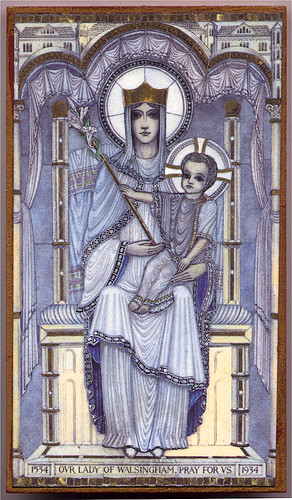Good Friday
The Rome of a thousand years ago and more as related by the Blessed Cardinal Schuster in his Liber Sacramentorum:
Christ had said, Non capit prophetam perire extra Hierusalem; for this reason the station is held today in the basilica known as Sancta Hierusalem, to which the Pope formerly went barefoot, walking in procession from the Lateran. He swung, as he went, a censer filled with precious perfumes before the wood of the true cross, carried by a deacon, whilst the choir sang Psalm csviii: Beati immaculati in via.
Originally, as a sign of deep mourning, this day was aliturgical, as were usually all the Fridays and Saturdays of the year in Rome. Thus, when towards the sixth century the rigour of the ancient rule was somewhat relaxed and the Friday stations of Lent were instituted, the Popes still continued for many centuries the ancient Roman usage, which excluded even the Mass of the Presanctified on this day. Therefore the present rite does not go back beyond the Middle Ages, and represents the order used in the titular churches in Rome, in which the Pope was never present.
The Adoration of the True Cross on Good Friday was taken, as we have already said, from the Liturgy of Jerusalem, where it was already in use towards the end of the fourth century. Indeed, for a long time, in the West also, this adoration formed almost the most important and characteristic part of the ceremony, the central point, as it were, of the whole Liturgy of the Parasceve. Ecce lignum crucis: this is the beginning of the parousia of the divine judge, and at the sight of the triumphal banner of redemption, whilst the Church prostrates herself low in adoration, the powers of hell flee away terror-stricken into the abyss.
In Rome in the Middle Ages the papal reliquary containing the true cross was sprinkled with perfumes, indicating thereby the sweetness of the grace which flows from the sacred wood, and the inner unction and spiritual balm which the Lord pours into the hearts of those who carry the cross for love of him.
According to the Ordines Romani of the eighth century, today's ceremony took place partly in the Sessorian Basilica and partly in the Lateran. Towards two o'clock in the afternoon the Pope and palatine clergy moved in procession barefoot from the Lateran to the stational basilica, where the Adoration of the Cross took place, followed by the reading of the Passion according to St John, and the Great Litany for the various ecclesiastical orders and for the necessities of the Church. The procession then returned to the Lateran. Singing as they walked the psalm Beati immaculati in via. On this day of sadness neither the Pope nor the deacons received Holy Communion, but the people were free to do so either at the Lateran, where one of the suburbicarian bishops celebrated, or at any of the titular churches in the city.
Towards the ninth century the rite was somewhat altered. The Adoration of the Cross was deferred until after the Litany, which was followed by the Pater Nostertogether with the Communion of those who were present. The procession of the Blessed Sacrament did not take place at that point, the ceremony ending with the Pope's blessing – “In nomine Patris et Filii et Spiritus Sancti” – to which the assembly replied: “Et cum spiritu tuo”. Everyone then recited privately the Vesper psalms, after which all went off to break their fast.
And if you were wondering, no, I have no idea why the font size changes in the above quote. It's not that way in the original and it's not that way on the work page. Blogspot just decided to do it. Mysterious are the ways of Blogspot, its wonders to perform.





























<< Home